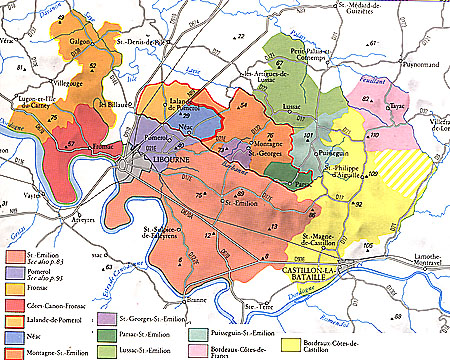
WineRegionsOld WorldFranceBordeaux
The Libournais district
The right-bank of the Dordogne river, known as the Libournais district,
is red wine country. Dominated by the Merlot grape, this district produces
deep-colored, silky, velvety rich wines of classic quality in Pomerol and
St.-Emilion and wines of modest quality but excellent value and character
in the surrounding, so-called "satellite" appellation.
To encompass all the great wines of this district, one need only draw a
boundary north from Libourne to Les Billaux, then southeast to St.-Christophe,
southwest to St.-Laurent, and back again to Lihourne, for this tiny area
contains all of Pomerol and the very best of St.-Emilion. This is where
the Merlot grape reigns supreme; seven out of every ten vines are of that
variety and it's succulent fruit is essential to the local style.
In the mid-195Os many Libournais wines were harsh, and even the best appellation
generally did not enjoy the reputation they do today Most growers slowly
developed the opinion that they were cultivating too much Cabernet sauvignon
and Malbec for their particular terroir and decided that they should plant
more Cabernet franc. A few growers argued for the introduction of Merlot,
which was allowed by the regulations, because it would give their wines
the suppleness they desired. Even if the growers could have agreed on united
action. however, changing the ence´pagement of an entire district
would have been a very long-term task, as well as being fantastically expensive.
However in 1956 frost devastated the vineyards, forcing the Liboumais growers
into action. With short crops inevitable for some years to come, prices
soared, enabling them to carry out the massive replanting program which,
ironically, they could not have afforded prior to the crisis. Just as there
was a positive side to phylloxera, so there was to the frost of 1956: it
led to the wholesale cultivation of Merlot and Cabernet franc, which established
a totally different style of wines, providing the catalyst for the spectacular
post-war success of St.-Emilion and Pomerol.
THE SATELLITES OF ST.-EMILION AND POMEROL
The wines of Lussac, Montagne, Parsac. Puisseguin, Sables and St.-Georges
were once sold as St.-Emilion, but in 1936 these outer areas were given
their own appellation. This was done to protect the image of the greatest
St.-Emilion chateaux, but through the established historical use of this
famous name the areas won the right to attach the name of St.-Emilion to
their appellation. The tiny Sables area was later reclaimed by the St.-Emilion
appellation, and Parsac and St.-Georges were merged with the Montagne St.-Emilion
appellation. The reduction in the number of these confusingly similar wine
names made sense, but the executive order that created the larger Montagne
St.-Emilion appellation did not disband Parsac-St.-Emilion and St.-Georges
St.-Emilion, and so a situation arose where the growers could choose between
two very similar appellation. All the wines of Parsac utilize the Montagne-St.-Emilion
appellation, but many growers in St.-Georges still sell their wines as St.-Georges-St.-Emilion.
All five of the St.-Emilion hyphenated appellation, produce wines of essentially
similar nature and with identical regulations.
